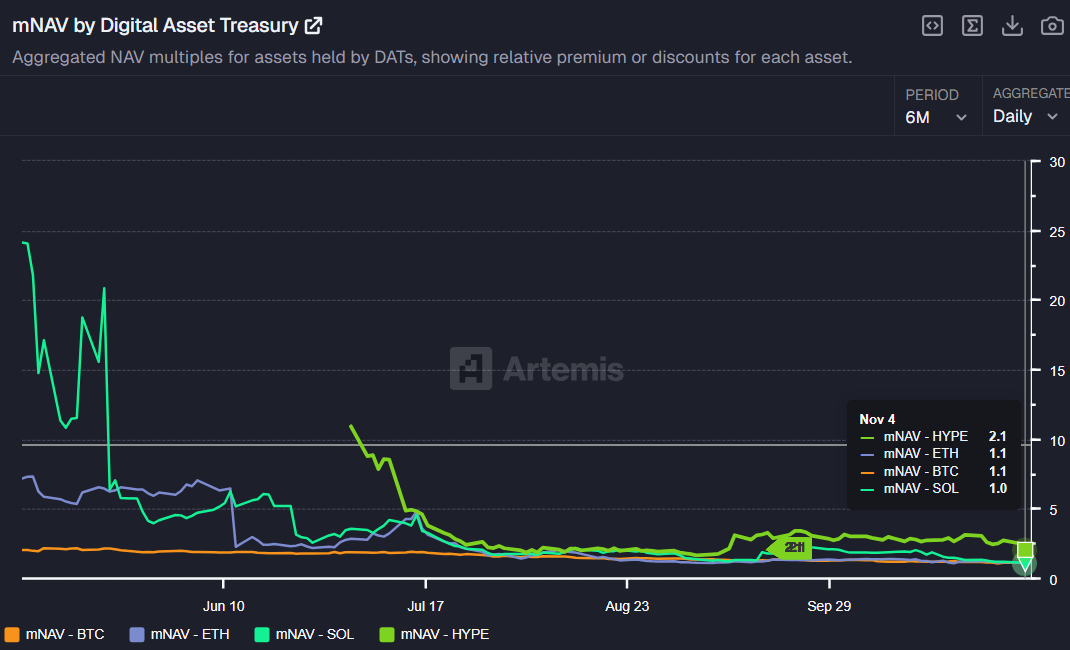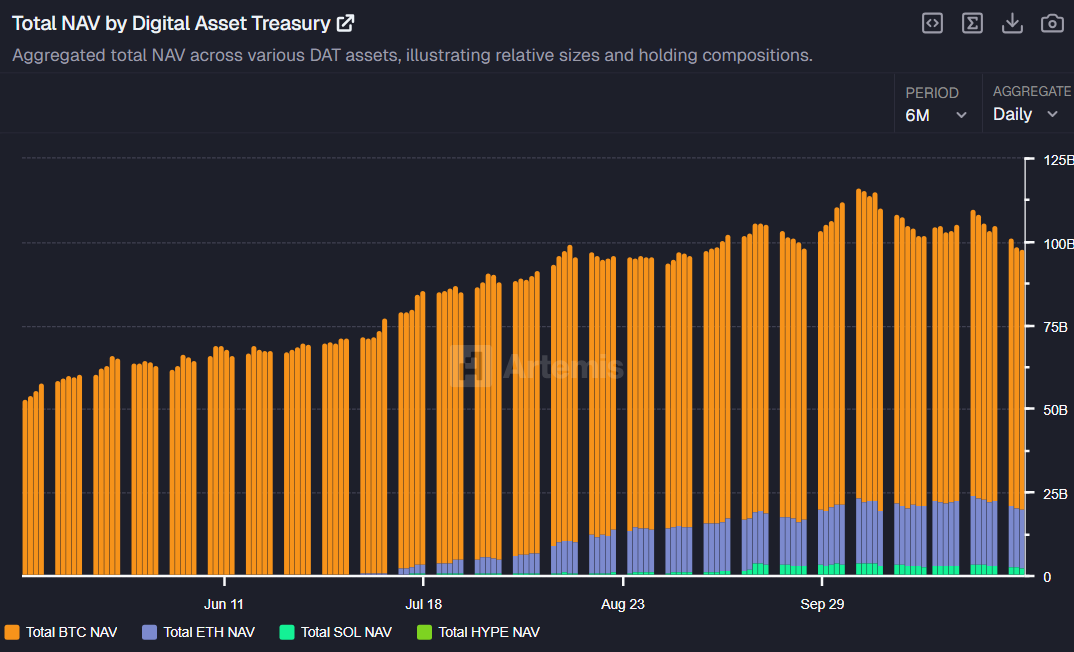Digital Asset Treasuries Are Collapsing: Lost Confidence Triggers Market Sell-Off
The market premium for DAT firms has vanished, with mNAV ratios nearing 1.0. Analysts attribute the recent crypto slump partly to mass liquidation by these corporate treasury groups.
The financial health of Digital Asset Treasury (DAT) firms, which constituted a major source of crypto market buying since the second quarter, is rapidly deteriorating.
Data released Wednesday by the on-chain data platform Artemis indicates that the market premium for these crypto-holding entities has largely evaporated. According to Artemis’s ‘mNAV by Digital Asset Treasury’ metric, the Market Net Asset Value (mNAV) of DAT firms, which once exceeded 25, is now converging toward 1.0.
mNAV Ratio Plummets Toward Zero
The mNAV ratio is a critical valuation metric calculated by dividing a firm’s market capitalization by the net asset value (NAV) of its digital holdings. An mNAV greater than 1 signifies that the market assigns a premium to the company’s stock.
This means the market is recognizing its operating ability or future growth potential beyond its current crypto portfolio value. Conversely, an mNAV below 1 suggests the stock is undervalued, signaling low investor confidence.
 mNAV by Digital Asset Treasury. Source: Artemis
mNAV by Digital Asset Treasury. Source: Artemis
The trend over the last six months has been sharp. Between May and June of this year, average mNAV for major DAT firms hovered between 1.9 and 2.0, even for conservative assets like Bitcoin (BTC).
However, this premium has severely diminished. As of Tuesday, the mNAV for BTC and ETH DATs is 1.1, while SOL DATs are 1.0. Even the outlier HYPE DATs have fallen to 2.1. Essentially, the premium once paid for gaining crypto exposure via DAT stocks has almost disappeared.
The resulting lack of confidence is visible in corporate balance sheets. The total amount of BTC held by DAT firms peaked at $92.6 billion on October 6 but has since fallen to $78.1 billion as of Wednesday. Similarly, ETH holdings dropped from a peak of $20.6 billion on October 27 to $17.6 billion, indicating significant market liquidation.
 Total NAV by Digital Asset Treasury. Source: Artemis
Total NAV by Digital Asset Treasury. Source: Artemis
DATs Called an ‘Exit Event’ for Prices
Omid Malekan, an Adjunct Professor at Columbia Business School, identified the decline of DAT firms as a root cause of the recent crypto price slump.
“Any analysis of why crypto prices continue to fall needs to include DATs, because in aggregate they turned out to be a mass extraction and exit event – a reason for prices to go down,” Malekan asserted.
Malekan criticized the business model, arguing that the significant costs associated with establishing public entities—particularly for shell/PIPE/SPAC structures, involving millions in fees to bankers and lawyers—mean that when investors buy DAT stock, they are effectively acquiring the underlying crypto at a steep discount due to these overhead expenses.
“There’s no free lunch. All the people who talked about DATs like they were pure upside are idiots who should not be taken seriously ever again,” he concluded bluntly.
Adding to the criticism, Matt Hougan, CIO of Bitwise Invest, suggests that DATs need more than mere coin accumulation to survive. He advised investors: “The best way to tell which DATs are worth paying attention to is to ask: Are they doing something hard?” Hougan warned, “If that’s all a DAT is doing, you are better off owning an ETF.”
Disclaimer: The content of this article solely reflects the author's opinion and does not represent the platform in any capacity. This article is not intended to serve as a reference for making investment decisions.
You may also like
Three things that must happen for Bitcoin to avoid bear market
A $500 billion valuation giant is emerging
With a valuation comparable to OpenAI and surpassing SpaceX and ByteDance, Tether has attracted significant attention.

Prediction markets meet Tinder: Can you place bets on Warden's new product by simply swiping left or right?
No need for chart analysis, macro research, or even inputting the amount of funds.

Why does bitcoin only rise when the U.S. government reopens?
The US government shutdown has entered its 36th day, leading to a decline in global financial markets. The shutdown has prevented funds from being released from the Treasury General Account (TGA), draining market liquidity and triggering a liquidity crisis. Interbank lending rates have soared, while default rates on commercial real estate and auto loans have risen, increasing systemic risk. The market is divided over future trends: pessimists believe the liquidity shock will persist, while optimists expect a liquidity release after the shutdown ends. Summary generated by Mars AI. The accuracy and completeness of this summary are still being improved as the Mars AI model is updated.

